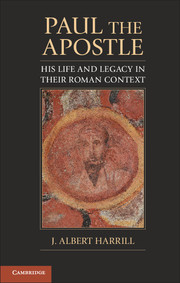Book contents
- Frontmatter
- Contents
- Figures and Boxes
- Preface
- Introduction
- PART I The Life
- PART II The Legend
- Appendix 1: Extant Writings Attributed to Saint Paul in Rough Chronological Order
- Appendix 2: Reconstructing Paul's Corinthian Correspondence: A Puzzle
- Appendix 3: Ancient Christian Works Containing Pauline Traditions and Legends
- Notes and Further Reading
- Bibliography
- Index of Biblical Citations
- Index
Appendix 2: Reconstructing Paul's Corinthian Correspondence: A Puzzle
Published online by Cambridge University Press: 05 November 2012
- Frontmatter
- Contents
- Figures and Boxes
- Preface
- Introduction
- PART I The Life
- PART II The Legend
- Appendix 1: Extant Writings Attributed to Saint Paul in Rough Chronological Order
- Appendix 2: Reconstructing Paul's Corinthian Correspondence: A Puzzle
- Appendix 3: Ancient Christian Works Containing Pauline Traditions and Legends
- Notes and Further Reading
- Bibliography
- Index of Biblical Citations
- Index
Summary
Because Paul must have written more than just two letters to Corinth (see 1 Cor. 5:9), biblical scholars have proposed various theories to reconstruct the complex history of the Corinthian correspondence. Although a few scholars still maintain the literary unity of 2 Corinthians (which is also a hypothesis), a current consensus agrees that 2 Corinthians 10–13 comes originally from a different letter. The identification of the other pieces of the jigsaw puzzle is an open question, however. Indeed, some scholars prefer to remain agnostic on the rest of the pieces rather than presume that we know what Paul wrote. To be sure, all the scholarly proposals are tenuous.
In order to provide readers with some kind of guide through the quagmire, I have decided to adopt as a working hypothesis a recent proposal (Mitchell 2005), which I and other scholars (Roetzel 2007 and 2009) find suggestive. Admittedly, it is little more than a series of hypotheses laden with guesses, without any more independent verification than any other theory. Yet it at least attempts to explain all the evidence. I outline this hypothesis next.
Letter 1 (not extant), mentioned in 1 Corinthians 5:9, ca. 52. Paul writes concerning some ethical matters.
Letter 2 (entire), our 1 Corinthians, ca. 53/54. Dealing with escalating internal conflicts over status in the congregation, Paul urges his believers to reconcile with each other as one body in Christ.
Letter 3 (extant only as a fragment), preserved in 2 Corinthians 8, ca. 54/55. Paul writes to raise funds for the Jerusalem churches.
Letter 4 (extant only as a fragment), preserved in 2 Corinthians 2:14–7:4 (excluding 6:14–7:1), ca. 55. Paul defends himself against charges of religious fraud. The excluded fragment likely comes from a separate letter, by rival missionaries to Corinth, attacking Paul (see Betz 1994).
Letter 5 (extant only as a fragment), the “letter of tears,” preserved in 2 Corinthians 10:1–13:10, ca. 55. Paul rebukes his congregation angrily for accepting the leadership of rival Christian missionaries (the “super apostles”).
Letter 6 (extant only as a fragment), preserved in 2 Corinthians 1:1–2:13; 7:5–16; and 13:11–13. The congregation has apparently turned to accept Paul's leadership, and so Paul writes for reconciliation while also underscoring his honesty and goodwill, ca. 55/56.
Letter 7 (extant only as a fragment), preserved in 2 Corinthians 9. His fight with the congregation now in the past, Paul administers the final stages of the collection for Jerusalem, ca. 56.
- Type
- Chapter
- Information
- Paul the ApostleHis Life and Legacy in their Roman Context, pp. 169 - 170Publisher: Cambridge University PressPrint publication year: 2012



